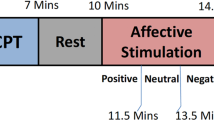Abstract
Spectral analysis of heart period variability was used to examine autonomic cardiac control in several tasks used in experimental and clinical assessments of autonomic nervous system function. Cardiovascular measures were recorded in healthy humans during quiet rest, reaction time shock-avoidance, cold face stress, and combined shock-avoidance/cold face stress. Shock-avoidance was characterized by symparhetic beta-adrenergic dominance, as evidenced by (1) shorter heart periods, (2) less highfrequency spectral power, (3) elevated low-frequency power, (4) increased ratios of low- to high-frequency power, and (5) a steep regression line fitted to the log-log plot of the power spectra. Cold face stress yielded (1) longer heart periods, (2) more high-frequency power, (3) decreased low-frequency spectral power, and (4) a flat regression slope, indicating vagal dominance. Quiet rest appeared as mildly vagal, with less total spectral power, and the combination task elicited a mixed vagal-sympathetic pattern. These results are discussed in the context of (1) the autonomic underpinnings of low-frequency power, (2) the autonomic effects of facial cooling, and (3) the utiliry of spectral analysis of heart period variability during autonomic challenge tasks for basic research and clinical application.
Similar content being viewed by others
References
Wolf S. Psychophysiological influences on the dive reflex in man. In: Schwartz PJ, Brown AM, Malliani A, Zanchetti A, edsNeural Mechanisms in Cardiac Arrhythmias. New York: Raven Press, 1978; 237–250.
Finley JP, Bonet JF, Waxman MB. Autonomic pathways responsible for bradycardia during facial immersion.J Appl Physiol 1979;47:1218–1222.
Obrist PA.Cardiovascular Psychophysiology. New York: Plenum Press, 1981.
Sherwood A, Turner JR. A conceptual and methodological review of cardiovascular reactivity research. In: Turner JR, Sherwood A, Light KC, eds.Individual Differences in Cardiovascular Responses to Stress. New York: Plenum Press, 1992; 3–27.
Malliani A, Lombardi F, Pagani M, Cerutti S. Clinical exploration of the autonomic nervous system by means of electrocardiography.Ann NY Acad Sci 1990;601:234–246.
Stein PK, Bosner MS, Kleiger RE, Conger BM. Heart rate variability: a measure of cardiac autonomic tone.Am Heart J 1994;127: 1376–1381.
Butler GC, Yamamoto Y, Hughson RL. Heart rate variability to monitor ANS activity during orthostatic stress.J Clin Pharmacol 1994;34:558–562.
Koh J, Brown TE, Beightol LA, Ha CY, Eckberg DL. Human autonomic rhythms: vagal cardiac mechanisms in tetraplegic subjects.J Physiol 1994;474:483–495.
Pomerantz B, Macaulay RJB, Caudill MA, et al. Assessment of autonomic function in humans by heart rate spectral analysis.Am J Physiol 1985;248 (Heart Circ Physiol):H151–3.
Saul JP. Beat-to-beat variations of heart rate reflect modulation of cardiac autonomic outflow.News Physiol Sci 1990;5:32–37.
Bronis M. Heart rate variability and autonomous system: some possible relations.Automedica 1983;4:223–225.
Raetz SL, Richard CA, Garfinkel A, Harper RM. Dynamic characteristics of cardiac R-R intervals during sleep and waking states.Sleep 1991;14:526–533.
Peng CK, Buldyrev SV, Hausdorff JM, et al. Non-equilibrium dynamics as an indispensable characteristic of a healthy biological system.Integrative Physiol Beh Sci 1994;29:283–293.
Goldberger AL. Fractal electrodynamics of the heartbeat.Ann NY Acad Sci 1990;591:402–409.
Goldberger AL, Rigney DR, Mietus J, Antman EM, Greenwald S. Nonlinear dynamics in sudden death syndrome: heartrate oscillations and bifurcations.Experientia 1988;44:983–987.
Thayer JF, Friedman BH. Assessment of anxiety using heart rate nonlinear dynamics. In: Ditto W, ed.Chaos in Biology and Medicine: Proc Int Soc Optical Engineering 1993;2036: 42–48.
Bernston GG, Cacioppo JT, Quigley KS, Fabro VT. Autonomic space and psychophysiological response.Psychophysiology 1944;31:44–61.
Colombo R, Mazzuero G, Soffiatino F, Ardizzioa M, Minuco G. A comprehensive PC solution to heart rate variability analysis in mental stress.1989 IEEE Comp Cardiol 1990: 475–478.
Grossman P, Karemaker J, Wieling W. Prediction of tonic cardiac parasympathetic control using respiratory sinus arrhythmia: the need for respiratory control.Psychophysiology 1991;28:201–216.
Hayano J, Sakakibara Y, Yamada A, et al. Accuracy of assessment of cardiac vagal tone by heart rate variability in normal subjects.Am J Cardiol 1991;67:199–204.
Latson TW. Princiles and applications of heart rate variability analysis. In: Lynch C, ed.Clinical Cardiac Electrophysiology. Philadelphia: J. B. Lippincott, 1994; 307–349.
Peckerman A, Hurwitz BE, Saab PG, Llabre MM, McCabe PM, Schneiderman N. Stimulus dimensions of the cold pressor test and the associated patterns of cardiovascular response.Psychophysiology 1994;31:282–290.
Peckerman A, Saab PG, Skyler JS, et al. Blood pressure reactivity and perception of pain during the forehead cold pressor test.Psychophysiology 1991;28:485–496.
Kawakami Y, Natelson BH, DuBois AB. Cardiovascular effects of face immersion and factors affecting diving reflex in man.J Appl Physiol 1967;23:964–970.
Zotterman, Y. Special sense: thermal receptors.Ann Rev Physiol 1963;15:357–372.
Kunitake T, Ishko N. Power spectrum analysis of heart rate fluctuations and respiratory movements associated with cooling the human skin.J Auton Nerv Sys 1992;38:45–56.
Abboud FM, Eckstein JW Active reflex vasodilation in man.Fed Proc 1966;25:1611–1617.
Engel GL. Psychological stress, vasodepressor syncope, and sudden death.Ann Intern Med 1987;89:403–412.
Kamada T, Miyake S, Kumashiro M, Monou S, Inoue K. Power spectral analysis of heart rate variability in type a's and type b's during mental workload.Psychosom Med 1992;54:462–470.
Mulder G, Mulder LJM. Information processing and cardiovascular control.Psychophysiology 1981;18:392–402.
Sloan RP, Shapiro PA, Bagiella E, Gorman JM, Bigger JT. Temporal stability of heart period variability during a resting baseline and in response to psychological challenge.Psychophysiology 1995;32:191–197.
Author information
Authors and Affiliations
Corresponding author
Additional information
This study was conducted at The Pennsylvania State University, when the authors were affiliated with that institution.
Rights and permissions
About this article
Cite this article
Friedman, B.H., Thayer, J.F. & Tyrrell, R.A. Spectral characteristics of heart period variability during cold face stress and shock avoidance in normal subjects. Clinical Autonomic Research 6, 147–152 (1996). https://doi.org/10.1007/BF02281901
Received:
Accepted:
Issue Date:
DOI: https://doi.org/10.1007/BF02281901




